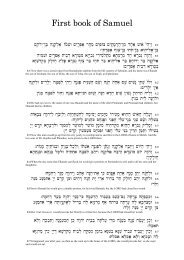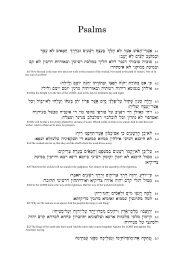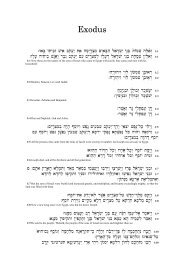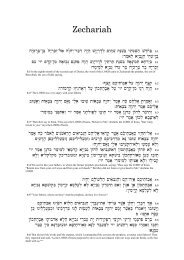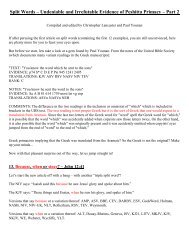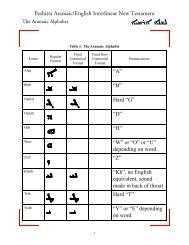ana translation
Untitled - Peshitta Aramaic/English Interlinear New Testament
Untitled - Peshitta Aramaic/English Interlinear New Testament
- No tags were found...
You also want an ePaper? Increase the reach of your titles
YUMPU automatically turns print PDFs into web optimized ePapers that Google loves.
Ixiv<br />
INTRODUCTION<br />
Some of the A-group exhibit the (apparently conflate)<br />
f Aj>Q*j2 A^**Z<br />
()QJ> = VTTO Sety/xa TTVPOS. But whichever of the A-readings is right,<br />
the B-reading is equally due to the resemblance between (AaCLMZ and<br />
A^.xZ, leading to the omission of the former.<br />
It will be noticed that in each and all of the above examples, the<br />
B-text is not only uncorroborated but (with the exception of example<br />
(e) where the B-reading is merely commonplace and pointless)<br />
is in itself<br />
improbable as being unsuited to the context in which it is found.<br />
This fact would not, of course, disprove the possibility that such readings<br />
existed in the exemplar used by the Philoxenian translator, though<br />
they would lower its value as a textual witness. But another feature,<br />
likewise found in common in all these examples without exception,<br />
cannot be thus dismissed from consideration. It is this, that (as above<br />
pointed out) in every case there is apparent to eye<br />
resemblance between the Syriac words wherein A and B differ<br />
utterly remote from one another in meaning<br />
and ear a close<br />
words<br />
which compels us to infer<br />
that one word has been written by mistake for the other ;<br />
while the<br />
Greek words represented by them are quite dissimilar inter se. For<br />
this fact Professor Merx has not accounted ;<br />
on his theory<br />
it is a mere<br />
accident that p*)OQ and )u>OQL look so much alike, (Ws.v"> and<br />
LO and ]KVv ^VQ, V!MQ.. and l**J ]'.*"** and<br />
and )AfiO,<br />
A */ and ]AjQ>jZ, while there is no likeness<br />
between ezriyi/wcrets (or en-tur^ara) and eTrayye'A/zara, KO and Aao?,<br />
av(D@v and Acu'AaTro?, yeAouw and vTrepoy/ca, KaXrjv <strong>ana</strong> clXiKpwij, TTOLWV<br />
and (fiXvapwv, VTTO irvp<br />
and Sety/^a TTV/OO?. If indeed such likeness, however<br />
close, appeared in but one instance, it<br />
might be set down to chance,<br />
though it would justify us in suspecting a mistake in that instance. But<br />
recurring as it does in every instance, it warrants us in drawing confidently<br />
the general conclusion that the outward resemblance between<br />
two Syriac words, and not the existence of a Greek variant, has caused<br />
the B-text to deviate from the A-text and from the Greek. For it<br />
cannot be a mere accident that in every one of these examples two<br />
dissimilar<br />
Greek words should be represented by two Syriac words so<br />
nearly alike in written (or spoken) form that either might readily be<br />
by inadvertence substituted for the other. Then, as between the two<br />
Syriac words which in each case have by their similarity led to the<br />
disagreement of the texts, we are bound to accept the one which by



